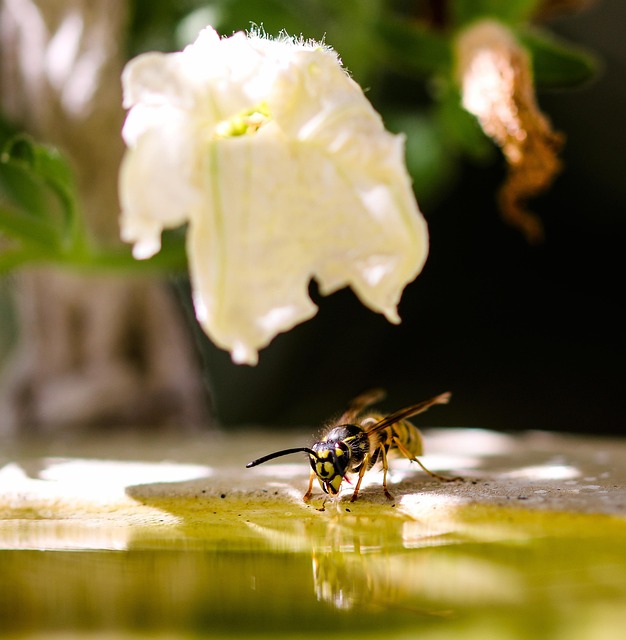Wasp behavior is driven by their need for sweet substances and protein-rich foods, making customized wasp control plans crucial. Professionals address attractants by sealing entry points, eliminating standing water, and conducting regular nest inspections. These tailored strategies reduce nest sites and food sources, creating safer environments while minimizing wasp disruptions. Regular maintenance, including gap sealing, secure trash disposal, and prompt cleaning, is key to preventing wasp attraction and ensuring family and pet safety.
Wasp infestations can disrupt your comfort and safety, but understanding their behavior is key to effective prevention. This guide offers professional advice on navigating the world of wasps, focusing on tailored solutions for your space. By identifying common attractants and implementing customized wasp control plans, you can significantly reduce their presence. Learn how to create a harmonious environment, free from these buzzing intruders, through strategic steps that ensure long-lasting results.
Understanding Wasp Behavior and Attraction
Wasp behavior is complex, driven by a need for food and shelter. They are drawn to sweet substances like nectar and fruit juices, which serve as energy sources. Additionally, wasps are attracted to protein-rich foods, especially meat and dairy products, that provide essential nutrients for their colonies. Understanding these attractants is crucial when developing a customized wasp control plan.
By identifying specific behaviors and preferences, professionals can create tailored strategies to reduce wasp presence. This may involve sealing entry points to prevent easy access to food sources, removing standing water where larvae thrive, and implementing regular inspections to identify and treat nests promptly. These proactive measures are key to minimizing wasp attractants and ensuring a safer environment.
Identifying Common Wasp Attractants in Your Environment
Wasp attractants can be found in various environments, and identifying them is a crucial step in implementing effective wasp control measures. Common attractants include sweet foods, drinks, and garbage left unattended. Wasps are drawn to fermenting fruits, sugary beverages, and even pet food dishes that are not regularly cleaned. Outdoor spaces with trash cans or compost piles can also become prime attractions for wasps looking for food sources.
Creating a customized wasp control plan involves addressing these attractants head-on. Regularly cleaning outdoor dining areas, promptly removing fallen fruits from trees, and securing garbage bins with tight-fitting lids can significantly reduce wasp activity. Additionally, maintaining a well-landscaped yard, trimming bushes and trees to minimize hidden nests, and sealing entry points in buildings can help prevent wasps from finding shelter and food sources nearby.
Creating a Customized Wasp Control Plan
Creating a Customized Wasp Control Plan is essential for effectively managing and reducing wasp attractants in your space. As professionals, we understand that every property is unique, with its own set of challenges and environmental factors. Therefore, a one-size-fits-all approach won’t cut it. A customized plan considers the specific needs and vulnerabilities of your property, taking into account aspects like the local ecosystem, structural features, and habits of wasp populations in the area.
This personalized strategy involves identifying potential entry points and sources of food or water that might attract wasps. It could include sealing gaps in walls or windows, properly maintaining landscaping to reduce standing water, and using specific traps or deterrents tailored to your situation. By combining these targeted measures, you can significantly minimize wasp presence while ensuring the safety and well-being of your family and pets.
Implementing and Maintaining Effective Wasp Prevention Strategies
Implementing effective wasp prevention strategies is key to reducing attractants and maintaining a wasp-free space. Customized wasp control plans tailored to your specific needs are essential, as one-size-fits-all solutions may not address all entry points or food sources. Professional pest control experts can assess your environment, identify potential nest locations, and implement targeted treatments to deter wasps from returning.
Regular maintenance is also vital. This includes sealing off any gaps or cracks in walls, windows, and doors, ensuring proper trash disposal with secure containers, and promptly cleaning outdoor dining areas after use. By eliminating potential hiding spots and food sources, you significantly reduce the likelihood of wasp attraction, making your space safer and more enjoyable for all.
By understanding wasp behavior, identifying attractants, and implementing tailored customized wasp control plans, you can significantly reduce their presence in your space. Consistent maintenance of prevention strategies is key to long-term success. Remember, a well-informed approach, combining knowledge with practical measures, will help create a more comfortable outdoor environment for you and your neighbors.
